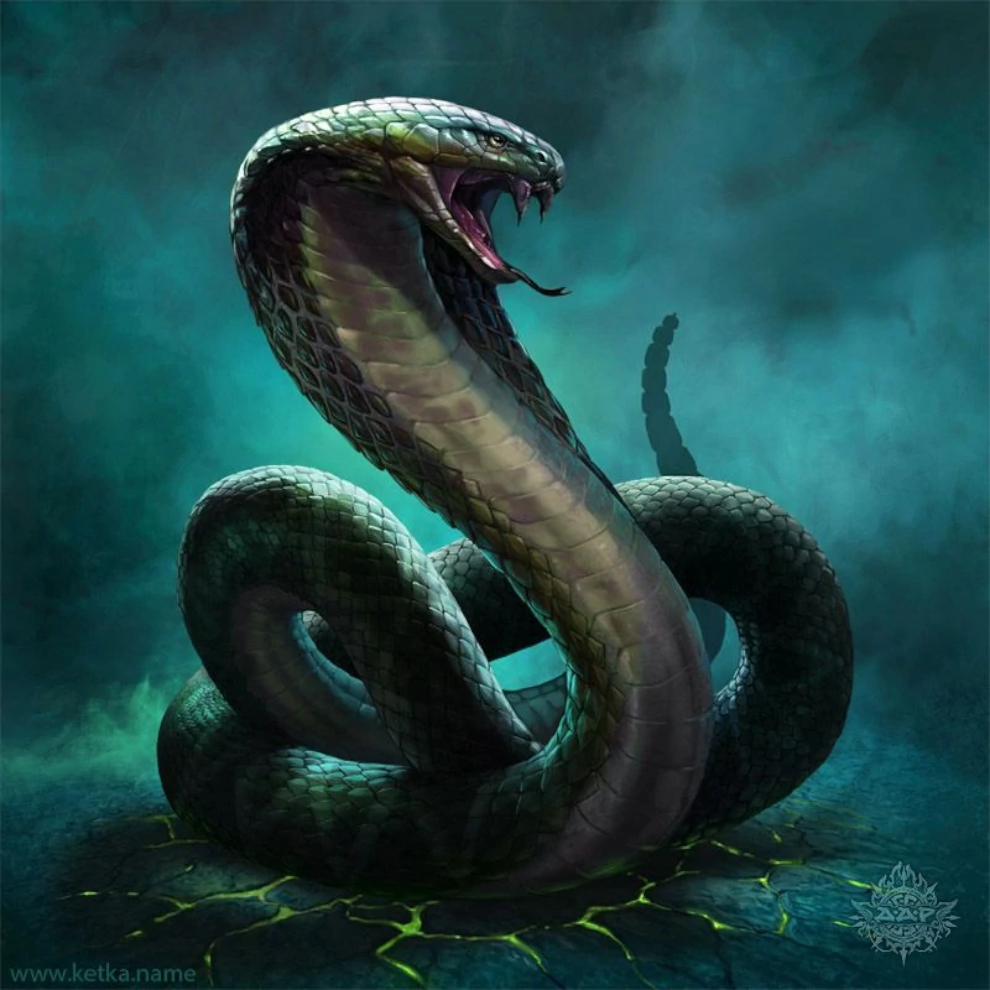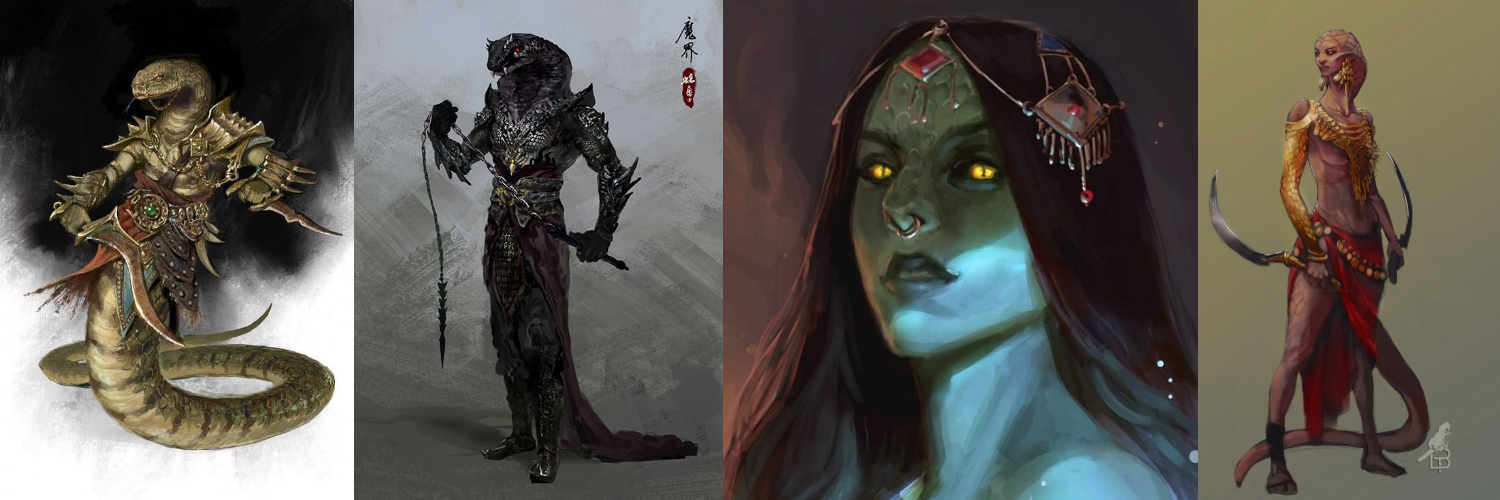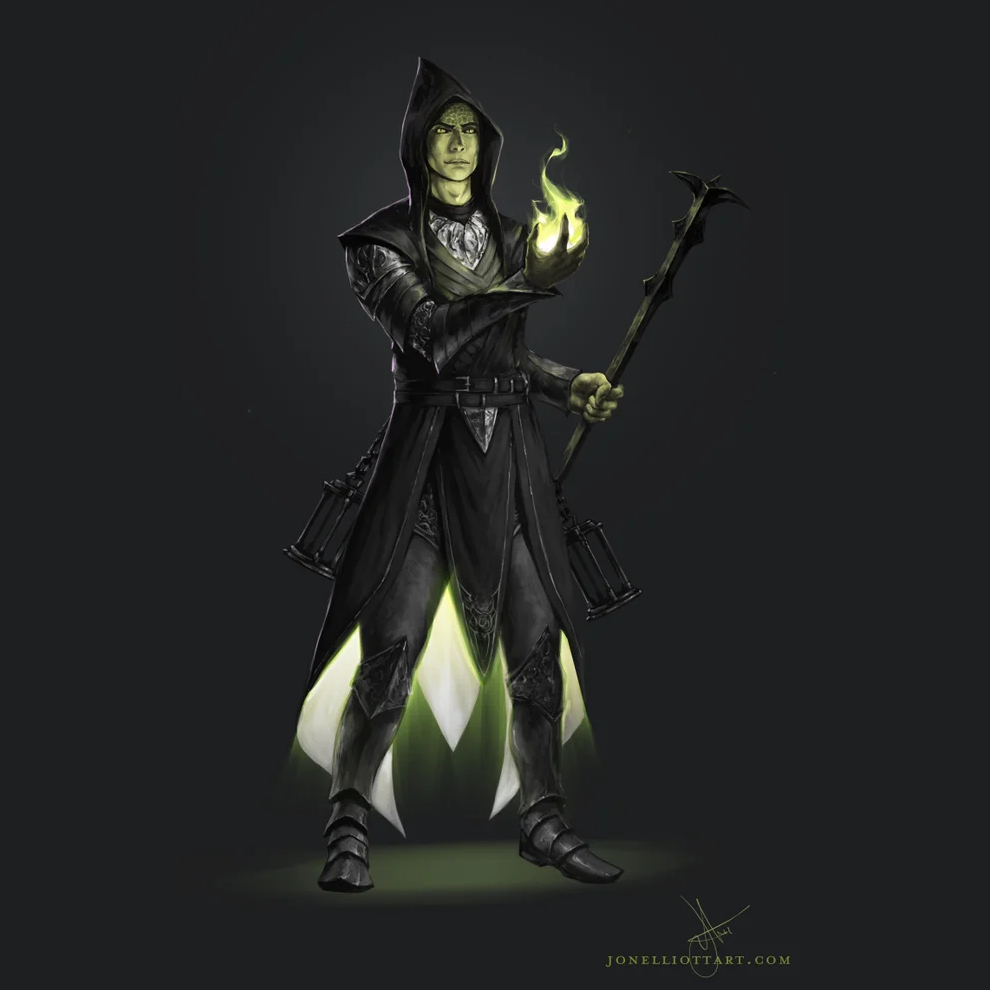Yuan-ti
Yuan-ti are a race of human-snake-hybrids cursed by the Empyreal Gods. In ages past they ruled a mighty empire that spanned continents and seemed to be destined to stand the test of time, but they earned the wrath of the gods. In the present day, yuan-ti are a rare and obscure people skulking in the shadows of the world desperately seeking to rekindle the lost glory of their race, their black hearts seething with hatred for the gods and the younger races alike.
The ancient yuan-ti empire was destroyed in the Divine Calamity and its people eternally cursed for their evil deeds. In those days, the baleful god-curse that was cast on the yuan-ti race was known as Sariel's Malediction, named after its creator, the Horseman of Plague. Since those ancient times, learned historians and other scholars have known the curse as the Empyreal Admonition. The yuan-ti themselves, however, have ever referred to their affliction as the Stillform due to its terrible effects. Stillform notably makes the yuan-ti immune to polymorphing and unable to shapechange, but it also plagues their species with a horribly high rate of physical defects and child death.
Contents
 Above: Entirely snake-formed yuan-ti.
Above: Entirely snake-formed yuan-ti.
Cursed Blood. Yuan-ti are afflicted by Stillform -- a divine curse that runs in your blood. This curse is hereditary but it cannot be contracted by other species; not through bites, not from spilled blood, or anything else for that matter.
Unchangeable Form. The bodies of yuan-ti cannot be transmuted, shapeshifted or polymorphed. They are immune to spells such as Polymorph and True Polymorph and any other similar spell that physically changes their form, but illusions and other such methods can still be used to alter their appearance. Additionally, yuan-ti can never make use of any shapeshifting powers, no matter whether they be granted by magical items or character class progression or any other source.
Physical appearance
Due to the effects of the Stillform the yuan-ti are a malformed species. Individuals can vary significantly in shape and size, some with animal features and others without. Stripped of their ancient gift of shapeshifting and immune to transmutative magics, each yuan-ti is doomed to live the entirety of their life in whatever body they are born with. Yuan-ti forms exist on a gradient scale between two polar archetypes: the body of a normal human and the body of a huge snake. The body of every newborn individual is a hybrid-form somewhere along that scale. Purely snake-like or purely human-like bodies are rare, while mixes of humanoid and serpentine features are common. The diversity of yuan-ti forms is nigh endless. Some yuan-ti are humanoids with the heads of snakes, while others are great serpents with human faces. Some are half-humanoid and half-snake, with a serpentine tail in place of legs. And outward variance is only half the story, for the hybridization of humanoid and serpentine anatomy prevails -- in its great diversity -- even beneath the skin.
Above: Yuan-ti with a human body.

by Ketka
Mental characteristics
Stillform influences not only the physiology of individuals but also their mental capacity. It is unclear if this is caused by the curse's effect on internal organs, or if it might simply be godly magic. In short, human-like yuan-ti are physically weak but intelligent, while serpentine yuan-ti are strong but dim-witted.Sex-based differences
Statistically, female newborn are much more likely to be humanoid in form, and males are more likely to be of serpentine forms. This correlates also with mental abilities, as noted in the previous section. Female yuan-ti are likely to be humanoid in anatomy and gifted with intelligence but limited by their physical frailty, while the opposite holds true for males. This binary distribution is not set in stone however; males can be born in human-form and females in serpenine form. It is a matter of propability, the balance of which must be asked of the Empyreal Gods. Learned scholars have guessed that the gods wanted to steer yuan-ti away from the patriarchal power structure of their evil empire.Sickness and disability
Because of Stillform, yuan-ti reproduction is not guaranteed to always produce biologically viable bodies for newborns. The seemingly random hybridization of physical form can cause debilitating and life-threatening malforities ranging from unsightliness to dysfuntcional organs -- sometimes organs can be missing, limbs can be severely underdeveloped or airways might have never opened. Infertility, lifelong sickness and infant deaths are devastatingly common for the yuan-ti.Social structure
Due to Stillform distributing mental and physical gifts to the genders in an uneven manner, yuan-ti societies tend to be matriarchal. The males are, on average, physically far superior compared to the females, but their minds are addled. Female yuan-ti on the other hand are smart and charismatic, dominating their societies with ease. Males typically act as workers, warriors and enforcers, while the females are leaders, supervisors, priests and spellcasters.Civilization and culture
Yuan-ti live in secret societies across Amanor, lurking in the shadows and furthering their dark schemes away from prying eyes. So adept are the yuan-ti at secrecy that their existence is not a well known fact to most mortals, although history books kept by scholars surely have some knowledge on them. Many a terrible conspiracy have they hatched over the millenia since the Divine Calamity, only to be foiled by adventurers, divine intervention or some other adversarial force. Yuan-ti societies are matriarchal, but their structures and sizes can vary from families to cults and perhaps even tribes. Most communities are very small in order to avoid detection. Not all yuan-ti are purely evil of course -- or bent of the salvation of their kind, for that matter -- with some communities being content with simple survival instead of attempts at renewed world domination. Leaders and elders of communities are responsible for preserving the culture of the yuan-ti race. This is accomplished mainly with oral tradition, although some ancient texts and other artifacts might have been preserved from before the Divine Calamity. Nonetheless, most yuan-ti communities have sparse contact with one another. In the thousands of years since the Divine Calamity, each of the isolated communities has had the chance to develop entirely unique cultural traits.Naming traditions
Aztec names tend to sound like the names for yuan-ti in D&D. Yuan-ti don't use family names. Recommended name generators:- Aztec names by FantasyNameGenerators.com
- Yuan-ti names by FantasyNameGenerators.com
Rules
Most yuan-ti statblocks from D&D 5e should be usable with the above described lore, requiring only minimal modification. Some significant house rules are listed below.
SYNONYMS
serpentkin, snake people PHYSICAL INFORMATION
Anatomy
Yuan-ti anatomy varies on a scale between two archetypes: entirely human anatomy and a massive snake. Most yuan-ti are born with bodies that lie on a scale between these two extremes, with any combination of anatomical traits being possible in theory.
Average height
Human-like proportions are typical for humanoid forms of yuan-ti. More animal-like forms are larger and taller -- or longer.
Average physique
Varies. Some are exceptionally muscular and big individuals, while others are frail and unable to grow stronger.
Body tint, color and markings
Varies. Scaley serpent-skin can be of varying colors with different kinds of patterns, most common shades are greens, cyans and browns. Human-skin can be of human-like color but also of previously mentioned snake-like colors.
Special characteristics
All yuan-ti, even the most human-like ones, have yellow eyes with vertical black slits for irises. Other bodily features vary greatly; fangs, tails, forked tongues and more are possible.
Perception and senses
Human-like senses on average. LIFE-CYCLE
Reproduction and birth
Biological reproduction; mating, 6-month pregnancy followed by birth of a single child. Breastfeeding possible. Human-like yuan-ti and serpentine yuan-ti might not have compatible reproductive organs.
Growth rate and stages
Fast-growing and long-lived. Maturity at 11-13 years. Can live up to 150-200 years. Developmental disabilities are common as caused by their cursed physiology.
Mortality and death
Yuan-ti die mundane deaths. Deaths from disability and physical defects are common. ECOLOGY
Origin or ancestry
Created by the twin gods Kukulkan and Quetzalcoatl at the end of the Dawn Age by bestowing magical gifts on ancient humans.
Distribution
Scattered in tiny communities across Amanor.
Habitats
Any.
Population
Very small population, and spread thin. SIGNIFICANT POPULATIONS
None
LANGUAGE
Yuan-ti have their own language with some reptilian vocalizations. Communication is made difficult by the fact that some yuan-ti are born with the vocal chords of snakes and some with those of humans while some are born with something in between and some with no usable vocal chords at all. RELIGION
Angranism RELATED ETHNICITIES
-
serpentkin, snake people PHYSICAL INFORMATION
Anatomy
Yuan-ti anatomy varies on a scale between two archetypes: entirely human anatomy and a massive snake. Most yuan-ti are born with bodies that lie on a scale between these two extremes, with any combination of anatomical traits being possible in theory.
Average height
Human-like proportions are typical for humanoid forms of yuan-ti. More animal-like forms are larger and taller -- or longer.
Average physique
Varies. Some are exceptionally muscular and big individuals, while others are frail and unable to grow stronger.
Body tint, color and markings
Varies. Scaley serpent-skin can be of varying colors with different kinds of patterns, most common shades are greens, cyans and browns. Human-skin can be of human-like color but also of previously mentioned snake-like colors.
Special characteristics
All yuan-ti, even the most human-like ones, have yellow eyes with vertical black slits for irises. Other bodily features vary greatly; fangs, tails, forked tongues and more are possible.
Perception and senses
Human-like senses on average. LIFE-CYCLE
Reproduction and birth
Biological reproduction; mating, 6-month pregnancy followed by birth of a single child. Breastfeeding possible. Human-like yuan-ti and serpentine yuan-ti might not have compatible reproductive organs.
Growth rate and stages
Fast-growing and long-lived. Maturity at 11-13 years. Can live up to 150-200 years. Developmental disabilities are common as caused by their cursed physiology.
Mortality and death
Yuan-ti die mundane deaths. Deaths from disability and physical defects are common. ECOLOGY
Origin or ancestry
Created by the twin gods Kukulkan and Quetzalcoatl at the end of the Dawn Age by bestowing magical gifts on ancient humans.
Distribution
Scattered in tiny communities across Amanor.
Habitats
Any.
Population
Very small population, and spread thin. SIGNIFICANT POPULATIONS
None
LANGUAGE
Yuan-ti have their own language with some reptilian vocalizations. Communication is made difficult by the fact that some yuan-ti are born with the vocal chords of snakes and some with those of humans while some are born with something in between and some with no usable vocal chords at all. RELIGION
Angranism RELATED ETHNICITIES
-



Comments